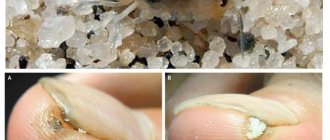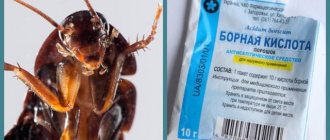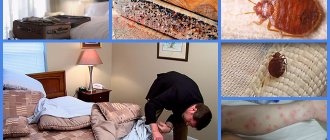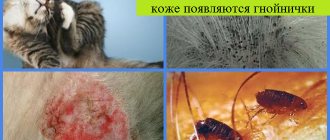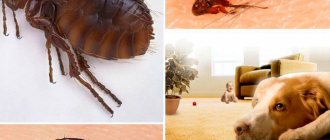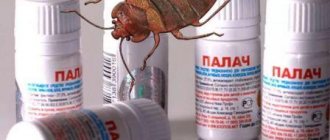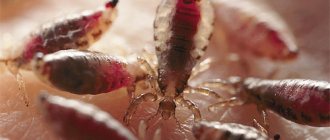The sand flea, also known as the Brazilian ground and penetrating flea, belongs to the Tunga family of blood-sucking insects.
Just like its other brothers, it is a blood-sucking parasite, and at the same time a carrier of dangerous infectious diseases.
- 10.1 Chemical control agents
Natural habitat
The largest populations of the parasite are observed in countries with warm climates. Optimal conditions for the development of sand fleas are in Vietnam, Sri Lanka, Thailand and Africa. Rare individuals can be found on European territory. The insect population grows very quickly on neglected beaches, landfills, quarries and other places where there is sand and water.
sand flea
Another place where a high concentration of the parasite has been observed is in Cuba. There, ideal conditions have been created for her: countless beaches, an abundance of sand, water and an optimal climate. A flea can choose almost any warm-blooded animal, including humans, as a carrier.
Tips on how to protect yourself
In an exotic country where there is a risk of encountering a sand flea, it is worth taking precautions in advance:
- wear rubber slippers when walking along the coastal sand;
- avoid getting sand on your skin;
- sunbathe only on a sunbed or mat;
- Treat your feet with repellent. It is effective for up to 5 hours;
- after visiting the beach, wash the sand off your feet;
- when visiting places with dense vegetation, wear closed clothing with long sleeves;
- do not step on puddles.
Note. Careful daily inspection of the area between the toes will help prevent the disease at an early stage.
https://www.youtube.com/watch?v=ytdevru
Sand fleas settle in places that are not disinfected. With proper prevention of the territory, premises and the beach, the parasite ceases to exist. The bite of this flea is painful and can lead to serious illness. Timely contact with a specialist, removal of the female flea and a prescribed course of antibiotics completely cures and restores the body.
Appearance of an insect
The sand flea looks like an oval disk. The insect's body is flattened and divided into three unequal parts: the head, the oblong belly and the sternum. The cover is smooth with a slight mirror effect. Mature individuals reach a length of 2 mm with a width of 1 mm.
A durable chitinous shell protects the pest from physical impact. There are three pairs of legs on the body, the hind ones are jumping: they are more developed and allow you to cover a distance of 3-5 cm in one jump. Depending on its habitat, the color of the parasite can vary from black to dark red. The family does not have wings.
Anatomy and life cycle of the sand flea
On the disproportionately small head of the insect there is a tiny pair of eyes. They also act as a sensor, allowing not only to navigate in space, but also to find a suitable place to get food.
The similarity of mandibles on the oral apparatus allows you to easily bite through thick skin, and thin tubes easily reach the capillaries, organizing a continuous supply of nutritious blood for the parasite. The food enters the insect's stomach and, after processing, is released as excrement.
For reference! Sand fleas have a special buffer where excess food is stored. At the same time, the insect inflates and increases in size, noticeably exceeding its original dimensions.
Life cycle of a flea:
- Egg . A grain of sand seemingly invisible to the naked eye. This period takes the insect about 2 weeks. One female can lay up to 300 eggs.
- Larva . White worm 2-4 mm long. It feeds on any organic matter: hair, dandruff, excrement, etc. Moves to the next period after 2-3 weeks.
- Doll . It is distinguished by its robust construction and the ability to fall into suspended animation for up to a year upon the onset of unfavorable conditions. The average development time is 3 weeks.
- Imago . A sexually mature insect capable of feeding and reproducing.
Reproduction
Adults live for about 6 months, the lifespan depends on climatic conditions and the abundance of food. The optimal temperature for the development of the parasite is from +25 to +30⁰С with a humidity of 40-60%.
What are sand fleas most often confused with?
Many people confuse the bite of a sand flea with the activities of other blood-sucking and parasitic insects. Therefore, many, in the fight against supposedly one pest, ignore the weaknesses of another, and sometimes contribute to its active development.
Similar activities are observed in the following insects:
- midges and mosquitoes;
- mites;
- ants;
- bedbugs.
Important! If you have a pronounced allergic reaction to insect bites, it is advisable to consult a doctor rather than engage in self-diagnosis. The course of treatment depends on the type of parasite, so specificity is extremely important here.
Treatment
Some of the obvious symptoms indicating a bite are tumors and unbearable scabies. Before applying medicinal products, the wound must be disinfected. Hydrogen peroxide is suitable for these purposes. After this procedure, you can use medications to help get rid of discomfort. They come in three forms:
- cream;
- repellent spray;
- pills.
Each remedy is effective at different stages, depending on the scale of the disaster and the size of the bite.
The most popular antihistamine creams are:
- yellow balm;
- Phenergan cream;
- Fenistil;
- Compound Dexamethasone Acetate Cream.
They perfectly relieve itching and pain, after which the desire to scratch the body disappears, in addition, they are suitable for children. To eliminate scabies and inflammation, you can also use hormonal agents based on hydrocortisone or sulfur ointment. Preparations containing Aloe Vera will have a calming effect.
Of the repellent sprays, Mentholatum Remos is the most effective.
Its action lasts up to 6 hours. In addition, it is suitable for children aged 4 years and older. You can also use Calamine lotion. This antiseptic speeds up the healing process.
Tablets are divided into antihistamines and antibiotics. Among antihistamines, cetirizine hydrochloride 10 mg (Cetirizine Hydrochloride) is effective. Suprastin and Zyrtec have less effect. These medications reduce scabies, but are contraindicated in children under 7 years of age.
https://www.youtube.com/watch?v=ytpressru
Antibiotics reduce the affected area and itching, but act more slowly than creams. For example, when taking Hapenxin XX 500mg in capsules, changes become noticeable only after 5-7 days, and complete recovery occurs after 7-8 weeks. As a rule, both types of tablets are used in combination. The downside is that medications can cause drowsiness.
In addition to medications, there are effective folk remedies that can eliminate itching after a bite. Their essence boils down to the effect of high temperatures on the affected area.
- If you direct a hot stream from a hairdryer to the bite site, you may feel relief. True, you need to blow carefully. Otherwise, you may get burned.
- Instead of a hairdryer, you can use hot cutlery - knives, spoons or forks. The device is placed in boiling water for a couple of seconds, and then applied to the affected area.
- Another alternative is a hot shower. You need to turn up the temperature, which is almost unbearable to endure. Of course, the skin will turn red, but after it is dried and moisturized with cream, the itching will go away.
It consists of antiseptic treatment, relieving swelling and itching. If the female has laid eggs in the wound, you should immediately consult a doctor. Carrying out removal procedures on your own is dangerous - the consequences can be very serious.
Treatments:
- Painkillers, cooling ointments and sprays.
- Antihistamine ointments or tablets.
- Antiseptics.
To treat contaminated premises, special disinfectants are sold in the form of sprays, ampoules and solutions. All treatment and protection products are sold in local stores and pharmacies.
Unfortunately, there is no vaccination to help prevent the consequences of sand flea bites.
We suggest you read: What is the difference between a louse and a flea?
If bites are detected, you need to observe them. If after 2 days the inflammation does not go away, but only increases, you should consult a doctor who will select the optimal treatment.
Calamine lotion or topical hydrocortisone cream will help relieve itching until medical attention is provided. You can use a handy remedy: dilute baking soda with water and apply it to the inflamed area. It is worth taking a painkiller to relieve pain.
If a male sand flea has bitten you, high temperatures will help relieve inflammation and itching faster: taking a hot shower. A heated cutlery applied to the bite site will ease the condition.
Routes of infection by sand fleas
The parasite lives not only in sand near water, but also in other places. The flea waits for a suitable host in bushes, grass and farmland. The insect can also be found in swampy areas, but its main carriers are animals. Even fleeting contact with an infected dog or cat is enough for a person to become infected with a dozen parasites.
Beach fleas attack the feet of tourists and the paws of animals. Subsequently, the insect moves higher - to the legs, groin and back. Very often the pest gets under the nails, where there are a lot of capillaries, as well as food.
Important! When visiting a foreign resort, you should avoid wild beaches.
The authorities of Thailand or Vietnam are very reluctant to carry out preventive measures in such places or do not treat them at all. The parasite bites tourists especially actively in September.
What to do if an insect bites you
It is important not to touch the itchy areas. Otherwise, the area of irritation will increase, and liquid will begin to ooze from the bite sites. The most unfortunate way is to give up on the problem without making any attempts to cure it. You cannot think that the reaction to a bite will go away in a few days. The tricky thing is that the longer the insect is under the skin, the stronger the inflammatory process.
Under no circumstances should you self-medicate or remove the body using improvised means. The flea is located next to the blood vessels, and if it is accidentally crushed by clumsily pulling it out, complications cannot be avoided. The female can only be removed surgically. The surgeon removes the insect with tweezers or sterile needles, treats the wound and bandages the operated area. If help is provided on time, the outcome is favorable.
So the best thing to do on vacation is to go to the hospital with health insurance.
The habitat of such insects is not far from human habitation, near water and farmland. They wait on the leaves of small bushes and grass, in the sand on the beach, in the ground near creeks.
Infection occurs when a tourist walks barefoot on beach sand, squats, or walks through thickets near water. The parasite affects the feet, legs, groin area and back. Often he chooses a place under the nail. There are many capillaries for easy obtaining of food.
Note. You should not visit wild beaches at the resort, especially in September. Sand fleas are especially active this season. Beaches are not disinfected by sifting sand.
The sand flea is very small in size and almost impossible to see. The bite is not felt; its location can only be discovered after a few hours.
Symptoms of a sand flea bite
The human body reacts to a sand flea bite almost instantly. Clear signs of infection begin to appear within 2-3 minutes after contact with the parasite.
Bite
Bite symptoms:
- redness;
- swelling;
- itching;
- an increase in the size of the problem area;
- painful sensations when touching the bite site;
- peeling of the skin;
- visibility of the parasite.
Important! If symptoms develop for more than two days, consult a doctor immediately.
It is extremely difficult to remove a tiny flea on your own, because the parasite is securely attached under the skin by means of tenacious legs.
How to recognize an insect bite
A tourist who is bitten by a sand flea may not suspect anything for at least several more hours. The maximum incubation period reaches 12 days.
The moment of the bite itself is not felt in any way, and the size of the insect, as mentioned above, does not exceed a few millimeters, so it is difficult to notice the flea. They live on dry and wet sandy beaches. It doesn’t matter whether the place is deserted or crowded - insects will always find a victim.
How to recognize a sand flea bite?
- The skin begins to itch.
- Most often the extremities itch – legs, especially feet, and arms. Damage to the body - neck, back, abdomen, groin - is possible. The genitals, lips, and back of the head may be affected.
- Over time, the itching becomes more intense, and bite marks become obvious. They are larger in size than mosquitoes, and the affected area swells up like a lump. A clear point is clearly visible in the center - the body of the insect.
- If the degree of attack is low, then there are no more than 5 lesions, and with the maximum form - over 30.
- Severe forms of infestation are more common among people of retirement age.
Those who are not particularly knowledgeable can easily confuse a flea bite with the way a bug bites. But the difference is that after the bite of the latter there are no cones left, and they mainly affect the legs.
How are bites treated in Thailand and Vietnam?
Insect bites at resorts are treated with local antihistamines. However, in difficult cases, this approach can be called rather preventive: if the parasite has penetrated the skin, then it is impossible to do without the intervention of a specialist. Local doctors constantly encounter such problems and know exactly how and with what to treat the consequences of the activities of beach insects.
Popular remedies for bites in Thailand and Vietnam:
- Yellow Balm;
- Compound Dexamethasone.
SAND FEA: SILENT BITE (SOUTHEAST ASIA, AFRICA, INDIA, THAILAND)
Those who like to bask on the warm sand under the rays of the sun are putting themselves in danger. A small and extremely serious parasite, the sand flea, awaits them on the beach. Moreover, you can find it not only in southern countries. Residents of mid-latitudes are also not immune to parasite bites. The flea is only 1–2 mm long. Insects do not have wings, but they have long legs that allow them to jump far. Both males and females bite humans. The bites of males resemble a mosquito bite - itching, redness, and mild pain appear. If we are talking about an attached female, then the signs are different: a swollen area of skin, the presence of a white abscess, a black dot in the center - the abdomen of the flea, severe pain. Accumulations of fleas are often observed near seaweed and along the surf line. If you hear a sound in silence that does not resemble the splashing of waves, it is better to leave the beach.
What to do: If you find suspicious abscesses or lumps on the skin, you need to go to the hospital to remove the flea. For itching, you can use antihistamines, anesthetic cream, or a compress with soda.
Photo: Getty Images
Consequences
If you do not see a doctor in time, there may be serious consequences. In some cases, after an insect bite, an allergic reaction occurs, which sometimes leads to the development of asthma or even anaphylactic shock. The problem gets worse when combing the problem area.
For reference! The bite of a female sand parasite is considered the most dangerous. She dives into the skin and lays eggs there. The process is accompanied by severe itching, burning and pain. If measures are not taken, the inflammation will develop into tungiasis, which can deprive a person of a limb.
Possible consequences of a bite
Consequences of a bite, and why they are dangerous:
- They bring painful sensations. If the itching caused by sand flea bites is not stopped with a special remedy, they turn into wounds and increase in size.
- Sepsis is blood poisoning. Scratching, given the hot climate, provides an opportunity for active proliferation of microorganisms in the wound.
- Allergy. It manifests itself as a rash and increased tissue swelling. Quincke's edema is a rare but possible response.
- Elephantiasis. Swelling and inflammation of tissues leads to stagnation of lymph, decreased blood circulation and pathological edema, which turns into a serious illness.
- Strong scratching of the wound leads to the death of tissue cells and traumatic (mechanical) necrosis.
- Deformation of fingers and nail plates. The “favorite” place for sand flea bites is the fingers, the area between them. Severe inflammation goes deep into the wounded area of the skin, causing irreversible consequences in appearance.
- Tetanus is a dangerous disease that affects the nervous system. Leads to painful cramps of the limbs, in some cases death.
- Ulcers. The infection spreads throughout the skin, causing ulcerative rashes throughout the body.
- Tungiasis.
- Untimely treatment leads to the formation of a deep wound - a fistula, which takes a long time to heal, leaving a scar.
After a bite from a male, which immediately detaches, a severe allergic reaction is possible; the bite site becomes very inflamed and itches for 2-3 days. Sometimes allergies progress to asthma and, in rare cases, anaphylactic shock.
You can get infected yourself by scratching the bites.
We invite you to read: Water fleas - photos and descriptions
https://www.youtube.com/watch?v=ytadvertiseru
After a female bite, ulcers may form and an inflammatory process may develop, which progresses to tungiasis. He needs to be treated so as not to lose his limbs.
Prevention and precautions
If you follow simple rules, the risk of infection with the parasite is significantly reduced. First of all, avoid wild beaches. The latter are a real breeding ground for sand fleas and other equally dangerous pests.
How to protect yourself from the parasite:
- Avoid going to the beach in the early hours and at sunset.
- Treat your skin with protective insect repellent creams after each bath.
- Wear socks and closed shoes.
- Maintain cleanliness and change bed linen regularly.
- After walking, wash your feet in soapy water.
Washing feet
Important! Before traveling to an exotic resort, you must get a series of vaccinations. Depending on the country, their list may vary. The doctor and tour operator should be aware of this.
Sand fleas - where they come from and why they are dangerous
The insects belong to the genus Tunga. The second name is considered to be “earthen flea”. They are considered distant relatives of rat and cat parasites. The width of the body does not exceed 1 mm, and the length is 1-2 millimeters. The brown shell is very strong, so it is unlikely that you will be able to crush a flea with your fingernail.
In addition to humans, domestic animals such as dogs and cats, as well as cattle such as sheep, horses and mules, become victims of pathogens. Attacks on monkeys, mice, elephants, and pigs are possible.
According to statistics, fleas most often attack those who do not wear shoes. Women suffer from bites less often than men. A surge in insect attacks is recorded in September. But in January you will hardly find parasites. By the way, these creatures of God bite people selectively. Out of 5-6 people located close to each other, they can attack only one.
The danger is that as a result of the bite of a female sand flea, you can lose your fingers and even die. This will be discussed in more detail below.
Speaking about the consequences of a bite, it is important to understand whether all sand fleas - both males and females - are equally harmful. If the victim is bitten by a male, the itching will not be intense. There is no need to fight it; it will go away on its own in a few days.
But if a tourist is attacked by a fertilized female, she will definitely need blood. This is the main danger. The fact is that the sand flea does not just bite, but gnaws into the epidermis. Most often, she chooses the skin under the nails and between the fingers. Then, due to special enzymes that dissolve the layers of the epithelium, it penetrates even deeper and is absorbed into the blood vessels for further replenishment.
We suggest you read: Is it possible to die from a wasp sting?
As a result, the parasitic tropical disease sarcopsillosis may occur. It is also called tungiasis, because, as mentioned above, sand fleas come from the genus Tunga. Complications of the disease are fraught with abscesses and even death.
https://www.youtube.com/watch?v=https:accounts.google.comServiceLogin
In addition, insects can cause terrible pathologies:
- sepsis;
- lymphostasis;
- lymphangitis;
- pneumonia;
- loss of nails;
- tissue necrosis;
- thrombophlebitis;
- ulceration to the very bones;
- deformation and even loss of fingers.
The pain from the female's bite is so severe that the victim, whose feet and legs are affected, has difficulty moving.
There are a number of ways to avoid encounters with sand fleas:
- Avoid visiting the beach at sunrise and sunset. An early morning boat trip along the edge of the coast is romantic. But it is precisely at this time that the parasites reach their highest activity.
- Apply repellent creams and oils to your skin after each swim. It is important that the repellent is local, it is more effective.
- Wear socks and shoes, and refrain from touching your naked body to the ground.
- Maintain cleanliness in the home.
- Wash your feet in warm water after walking.
- Avoid shady places on the beach.
In addition, before traveling to an exotic country you need to get vaccinated. Some tourists advise not to lie on the sand at all, but to sunbathe exclusively on a sun lounger. But it is worth considering that fleas can jump high.
Ways to get rid of sand fleas
At the first signs of the appearance of a parasite, no matter where: on the human body, on a pet or on interior items, disinfection should be carried out urgently. Otherwise, after a short period of time, there will be many more insects.
Chemical control agents
Not only interior items need to be treated, but the entire room: floors, walls, baseboards and crevices where the parasite can hide.
Effective preparations for sand fleas:
- Tick Lawn Spray;
- T Room Fogger;
- Get;
- Tick Carpet Spray.
Traditional methods
The clear advantage of this approach is accessibility and a much lower likelihood of developing allergies. However, in difficult cases, such remedies against fleas are ineffective.
Traditional methods:
- Treat all items with a mixture of baking soda and salt.
- Place bunches of wormwood and/or tansy around the room.
- Ventilate the room as often as possible when the temperature outside is low.
- Place pine shavings in areas where fleas are concentrated.
Insects with which the sand flea can be confused
Its small size makes it possible to confuse a flea with ants, midges, mosquitoes and bedbugs.
Differences:
- Ants do not bite, they move by crawling “in a herd.” They are attracted to the smell of food.
- Midges fly and bite. The bites are smaller than flea bites, the itching goes away faster. They fly in flocks, peak activity is in the evening and morning.
- Mosquitoes bite in shady places, at dusk and dawn. The characteristic buzzing sound is difficult to confuse with anything.
- Bed bugs live indoors. They attack at night, the itching after the bite can be confused with flea infestation. To determine which insect bit you, you need to inspect the bedding. After a bedbug attack, blood stains remain.
https://www.youtube.com/watch?v=ytpolicyandsafetyru
A distinctive feature of fleas is their jumping ability. Other insects, with which a flea can be visually confused, do not have this quality.
While on vacation, you should take good care of yourself and conduct a self-examination after visiting the beach. Pay attention to local residents - if there is a problem with parasite infestation, this can be immediately determined by their feet. Protective equipment and clothing will help minimize the risk of being bitten.
It's good to know the enemy by sight. It’s even better to distinguish between its other varieties. In Thailand, other insects can be mistaken for sand fleas. True, their bites are not so dangerous.
- Mosquitoes and midges. Their bites are very similar to flea bites, but are essentially harmless.
- Ants. They can take revenge on a person if he accidentally crushes them with his hand or body. They usually crawl on people by accident. An ant bite leaves a lump that may hurt for some time.
- Bedbugs. They are extremely rare. Mostly in bungalows and not very well maintained hotels. After bedbugs, a “path” of bites remains, but the affected areas never swell.
